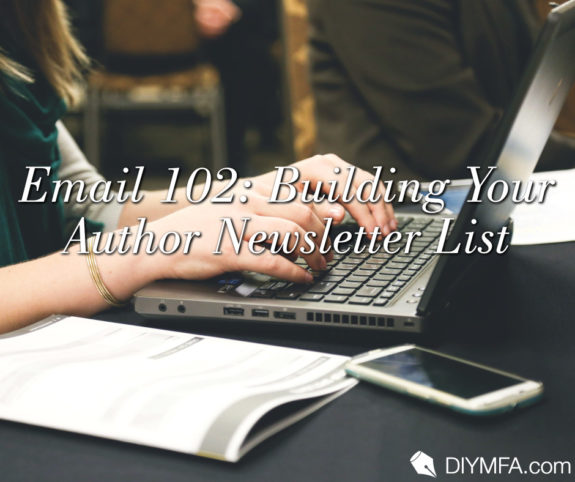Don’t Do What I Did: Mistakes in Indie Publishing
When I started my indie career, I made a lot of mistakes with my email list. I knew I needed a mailing list, but I didn’t know the best way to get addresses legally and ethically or what to do with them once I had them. Sure, I knew I had to send subscribers a newsletter, but how often should I write to them? What should I say? “Yeah, still working on the book…?” I might be new to email marketing, but even I recognized that I could only rephrase that sentence a finite number of times before the eyeballs started rolling.
I’ll presume you’re not in the dark about why you need a mailing list or how to get started with one, but you might like some list-building best practices. Here are six tips on building a mailing list that I wish someone had said to me when I was starting my writing career.
1. Write to your email list at least once a month
Once a week is better. Write less frequently than once a month and you risk people forgetting who you are and why they signed up for your list. Trust me, I learned this the hard way. As a profound introvert, I felt like a newsletter should contain…well, news. And I didn’t judge the contents of my life to be especially newsworthy. When I finally sent a second newsletter, who opened my email? My mom. Two college roommates. The others I could count on one hand.
A tip I learned from Kristin Oliphant helped me get over the newsworthiness hurdle. She recommended reframing the idea into it’s just an email you’re sending to a friend. Once I latched on to that idea, the prospect of writing a monthly author newsletter became much less daunting.
2. You don’t have to impress, they like you already
Your email subscribers likely signed up for your list because they either stumbled across your website and liked what they saw, or they read a short story or another sample of your work and want more. You’ve already sold them. What they want is you, so don’t be afraid to share yourself.
3. It’s okay to experiment
So much advice insists that success demands brand consistency. I fretted and stewed over what my emails should contain and how I should present the content. I let perfect become the enemy of good. When you’re new to email marketing and you don’t have many subscribers, aim for good enough.
This is a marvelous time to experiment. Think about what newsletters you subscribe to and you enjoy. How often do they send messages? What do you like about them? What’s their tone? Can you borrow an idea here, an idea there, and give them each a twist to make them your own?
If your email service provider permits it, try some A/B testing and see which messages generate the best responses. Now’s the time to test and refine, so when you scale up, you’ll have a winning formula in your pocket.
4. Readers want a novel, novella, or short story for a magnet.
A reader magnet is the literary equivalent to the free cheese cube at the grocery store that entices shoppers to buy a half-pound of the fancy stuff. Food samples may have disappeared from the landscape in the age of coronavirus, but the reader magnet freebie is still going strong.
But like free food, not all magnet samples are created equal. While some sources will tell you that any freebie—a piece of research, your character profiles, or a deleted scene from your novel—is good enough, the truth is that new subscribers want a completed piece of literature.
You’ll get far more sign-ups with a novel, a novella, a short story, or a handful of poems than you will with other magnet types. Perhaps after a year or more, once you’ve built a relationship with your readers, they’ll be receptive to taking a peek behind your writing curtain, but if you’re writing fiction, such material isn’t strong enough to convert browsers into subscribers.
5. Use promo services to get into the community
Use that reader magnet novel, novella, or short story with services like BookFunnel, StoryOrigin, or ProlificWorks to find new readers. Authors on these sites regularly put together group giveaways and other promotions. Participating authors agree to share the promos via social media and their newsletters, exposing your work to thousands of potential fans.
These services work especially well for genre fiction, as the promo organizer often customizes them to a single genre. But sometimes they’re organized around other principles, like inclusion in Kindle Unlimited or promotional sale prices. You can also reach out to individual authors through these services and agree to swap mentions of your books in each other’s newsletters. This is a great technique to employ before a launch.
6. Prune your email list regularly and ruthlessly
This one hurts, but think of it as a vaccination against spam.
You’ve worked hard to collect those email addresses and watching those subscriber numbers rise definitely boosts self-confidence. But look into your stats and you’ll see plenty of people who seldom open your emails. In the long run, these people hurt your reputation as an email marketer.
Services like Google regularly evaluate the reputations of every email sender to determine who’s sending spam. Even if your subscribers verified their desire to be on your list via double opt-in, if they don’t open your emails, they tarnish your reputation as a sender. Over time, these slights can hurt your ability to acquire future subscribers.
To avoid this, do two things on the front end.
- Set up an automation “onboarding” sequence. This is a brief series of emails you write ahead of time that get sent automatically when a subscriber first joins your list. Send these a few days or a week apart, when you’re still fresh in the subscriber’s mind. This trains the subscriber to be on the lookout for your messages, and the increased open rate signals to the email service provider you are not a sender who should get sent to spam.
- Second, assess your list every month. If you identify subscribers who haven’t opened a message from you in six months (or less, if you prefer), give them one final chance to stay on your list. Use a clear heading like, “Do you want to stay on my list?” If they don’t open it, delete them. Furthermore, if your list is large enough, you may be paying to carry these subscribers. Why pay for dead weight?
There’s even more information on how to build your email list in the DIY MFA Pixels to Platform Course. Trust yourself and be fearless! A beautiful new world of reader relationships awaits you.

Helen J. Darling writes and publishes contemporary women’s fiction at her imprint, Bricolage Books. She published her first novel, I’ll Know Me When I Find Me, in January 2018. Her latest novel, Terms and Conditions, was published in November 2019. You can connect with her at itshelendarling.com, on Instagram, Twitter and on Facebook.







